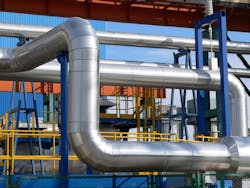Below are some best practices on how to approach equipment that has met with some or considerabler water damage. Topics addressed are electrical equipment, interior component replacement, cleaning agents and abrasives and additional references.
Wet Electrical Equipment
Electrical equipment that has been submerged or come into contact with water must be replaced, though there are exceptions to this rule for larger equipment, which may be able to be reconditioned by trained factory service personnel. Equipment that may be reconditioned includes:
- Switchboard enclosures and certain bus structures;
- Switchgear;
- Low-voltage power circuit breakers;
- Medium-voltage circuit breakers;
- Low-voltage bolted-pressure switches;
- Medium-voltage switches;
- Motor control center enclosures and bus structure;
- Panelboard and load center enclosures;
- Liquid-filled power transformers;
- Cast-resin transformers; and,
-
Busway: epoxy coated bars.
Attempting to dry out the equipment (in many cases) leaves portions of the current-carrying parts with damp or wet surfaces. These surfaces may be in contact with insulators or other materials that prevent them from being properly dried out and cleaned of debris.
Residual debris or wet surfaces may result in a loss of dielectric spacing within the equipment, and could present a hazard upon re-energization.
Equipment that must be replaced in its entirety is listed below:
- Miniature and molded case circuit breakers;
- Molded case switches;
- Multi-metering equipment;
- Safety switches (AC and DC);
- Load centers or panelboard interiors;
- Dry-type transformers;
- Busway: mylar wrapped bars;
- Solid state components;
- Programmable logic controllers;
- Fuses;
- Electromechanical relays, contactors, starters, push buttons, limit switches, and other input logic and output controls;
- Solid state motor starters;
- Adjustable speed drives;
- Motor control center components.
Equipment with Field Replaceable Interior Components
Generally, this type of replacement is limited to a load center or panelboard type of product where the entire assembly can be removed and replaced as a unit. In this case, there is a possibility that enclosures can be reused if they have not been subjected to physical damage and if they have been properly cleaned of all debris and foreign materials.
Cleaning Agents and Abrasives
Do not apply cleaning agents, particularly petroleum-based cleaners, to the current-carrying portions of electrical equipment to remove foreign debris, residues and other substances. Some cleaning and lubricating compounds can cause deterioration of the non-metallic insulating or structural portions of the equipment. Do not use abrasives such as sandpaper or steel wool to clean current-carrying parts of the equipment. These materials may remove plating or other conductive surfaces from the parts, which could result in a hazard when the equipment is re-energized.
Non-Submerged Equipment in Flooded Areas
Equipment in this situation should be inspected carefully by a qualified person to determine whether moisture has entered the enclosure. If any signs of moisture or damage exist, the equipment should be replaced or repaired.
Additional References:
NEMA Standard AB 4-2003, Guidelines for Inspection and Preventive Maintenance of Molded Case Circuit Breakers Used in Commercial andIndustrial Applications
NEMA Standard BU 1.1-2000, General Instructions for Proper Handling, Installation, Operation, and Maintenance of Busway Rated 600 Voltsor Less
NEMA Standard PB 1.1-2002, General Instructions for Proper Installation, Operation, and Maintenance of Panelboards Rated 600 Volts or Less
NEMA Standard PB 2.1-2002, General Instructions for Proper Handling, Installation, Operation, and Maintenance of Deadfront DistributionSwitchboards Rated 600 Volts or Less
NEMA Standard ICS 1.1-2003, Industrial Control and Systems: Safety Guidelines for the Application, Installation, and Maintenance of SolidState Controls
Grant Gerke ([email protected]) is the Digital Managing Editor at Automation World magazine.
About the Author
Grant Gerke
Digital Managing Editor

Leaders relevant to this article:
